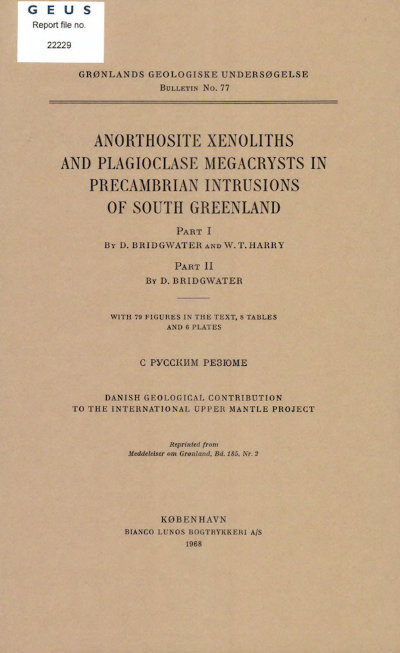Anorthosite xenoliths and plagioclase megacrysts in Precambrian intrusions of South Greenland. Parts I and II
DOI:
https://doi.org/10.34194/bullggu.v77.6617Abstract
Felspathic inclusions in Gardar igneous rocks are found over an area 70-150 km broad and at least 200 km long. This area is crossed by E-W trending transcurrent faults and contains the major Gardar alkali intrusive centres. The inclusions are of two main types: anorthosite xenoliths and plagioclase megacrysts. Some minor intrusions contain over 80 % of included felspathic material. The xenoliths reach a maximum size of several thousand square metres in plan. The majority are granular anorthosites, composed of labradorite (An61), olivine (Fa27-40), Fe-Ti oxides, and rare ortho- and clinopyroxenes. Xenoliths of laminated anorthosite, composed of labradorite (An56), olivine (Fa30) and interstitial ilmenite and clinopyroxene, are found in gabbros from a restricted area close to younger syenite intrusions. Secondary anorthosite xenoliths, composed of derived fragments of granular anorthosite, rare laminated anorthosite or plagioclase megacrysts, set in a younger gabbroic host, are common. The interstitial host in the secondary anorthosites may be reduced to a thin film of altered mafic material surrounding closely packed felspathic fragments. The plagioclase megacrysts, which reach 2 m in length, range in general from labradorite to calcic oligoclase. Single examples of bytownite have been noted in one Gardar dyke where they are found in small anorthositic aggregates with orthopyroxene (Fs22) and olivine (Fa27). The megacrysts are commonly clear and glassy; some are black and show a smoky discolouration in thin section. The colouration is thought to be due to the state of the iron in the felspar which is in turn related to the amount of water present. No major chemical differences have been found between black and clear felspar. Both varieties of megacrysts and many of the felspars from the anorthosite xenoliths show abnormal structural properties when examined using either the universal stage or X-ray techniques. The type of inclusion is clearly related to the composition of the host rocks; olivine gabbro hosts contain large anorthosite xenoliths and scattered calcic labradorite megacrysts; less basic gabbroic hosts contain large sodic labradorite megacrysts and secondary anorthosites; while trachydoleritic hosts contain smaller andesine megacrysts. The xenoliths and megacrysts are regarded as products of early crystallization of the same Gardar magmas as later gave rise to their hosts. The granular anorthosites are thought to be the brecciated remnants of a felspathic roof formed by the flotation of plagioclase in a little-fractionated Gardar basalt magma at depth. It is suggested that this magma may have become stratified while still in the liquid phase so that there was an increase in the amounts of Na and K in the upper part of the chamber. As the magma differentiated the density difference between magma and felspar became less and the plagioclase crystals remained suspended. This resulted in the formation of large sodic labradorite crystals which were never compacted together to form solid anorthosite. The early removal of a large amount of plagioclase-forming material and the suggested upward concentration of alkalies are believed to be two of the major processes controlling the formation of the Gardar alkali rocks.
Downloads
Published
Issue
Section
License
This article is distributed under a CC-BY 4.0 licence, permitting free redistribution and reproduction for any purpose, even commercial, provided proper citation of the original work. Author(s) retain copyright over the article contents.


